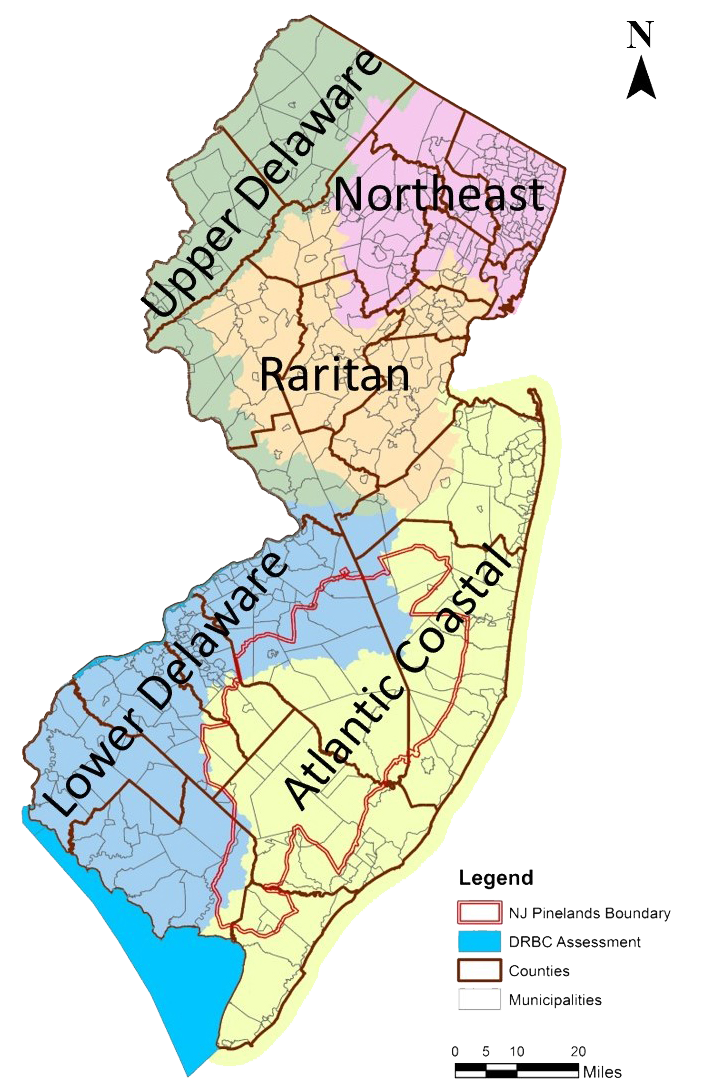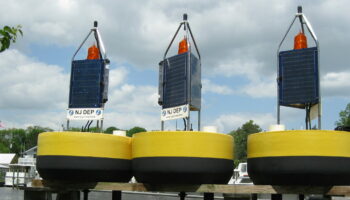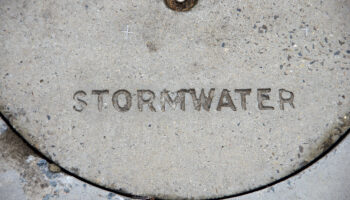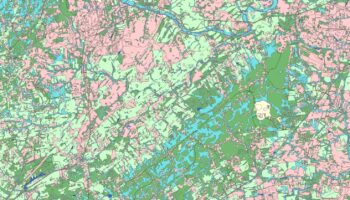
Water Quality Assessment
Comprehensive water quality assessment report that determines the health of New Jersey’s water resources.
Access databases where publicly-available water quality data is stored. Description of DEP and non-DEP monitoring programs statewide.
DEP advisories on current and historical water quality conditions. Relevant water quality reports and special studies.
Description and access DEP programs focused on protecting, preserving, and restoring water quality throughout the state.
DEP Geographic Information System (GIS) tools and data showcasing water quality information.
What's New
- Final 2022 Integrated Report published in May 19, 2025 NJR 2022 Response to Comments
- Data request for future Integrated Reports
- Updated Water Quality Methods Document Coming Soon
 New Jersey’s surface waters provide much of the water used for drinking water supplies, recreation, fishing, boating, swimming, commercial fisheries including shellfish, and tourism, all of which support our State’s ecology, economy, and quality of life for our residents. New Jersey conducts a statewide assessment of water quality every two years. This includes an intensive assessment of one of New Jersey’s five water regions each assessment cycle. A different water region is selected each assessment cycle on a rotating basis.
New Jersey’s surface waters provide much of the water used for drinking water supplies, recreation, fishing, boating, swimming, commercial fisheries including shellfish, and tourism, all of which support our State’s ecology, economy, and quality of life for our residents. New Jersey conducts a statewide assessment of water quality every two years. This includes an intensive assessment of one of New Jersey’s five water regions each assessment cycle. A different water region is selected each assessment cycle on a rotating basis.
Learn more about Integrated Water Quality Assessment, the Rotating Regional Approach, and the Assessment Program by selecting the bars below.
New Jersey employs an integrated approach to assessing water quality by compiling a vast amount of water monitoring data and related information collected by numerous sources throughout the State and evaluating it to determine the health of New Jersey’s surface waters. This statewide assessment of water quality is conducted every two years and includes an intensive assessment of one of the five water regions each assessment cycle. A different water region is selected each assessment cycle, on a rotating basis. This integrated water quality assessment process is used to determine if water quality conditions have changed over time; if water quality standards are met and if designated uses, such as recreation and water supply, are fully supported; to identify causes and sources of water quality impairment; and to develop restoration strategies for impaired waters and protection strategies for healthy waters. New Jersey’s integrated water quality assessment process includes assessing if all freshwaters fully support the drinking water supply use, it does not assess drinking water quality. Information about drinking water quality is available from the Division of Water Supply and Geoscience’s website.
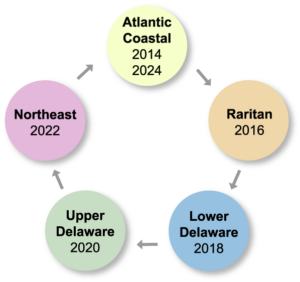
Since 2014, New Jersey has employed a rotating regional approach to integrated water quality assessment required under Sections 303(d) and 305(b) of the federal Clean Water Act. Under this approach, the New Jersey Department of Environmental Protection conducts a streamlined assessment of statewide water quality along with a more comprehensive, detailed assessment of water quality in one of New Jersey’s five water regions, Atlantic Coastal, Raritan, Lower Delaware, Upper Delaware and Northeast (see figure) each assessment cycle. This rotating regional approach will produce a comprehensive assessment of the entire state every ten years and will support development of measures to restore, maintain, and enhance water quality tailored to the unique circumstances of each regions. This approach is consistent with recent U.S. Environmental Protection Agency (USEPA) guidance for administering the federal Clean Water Act Section 303(d) Program entitled: Long-term Vision for Assessment, Restoration, and Protection under the Clean Water Act Section 303(d) Program , as explained in New Jersey’s approach for implementing the new USEPA guidance, entitled: New Jersey’s Vision Approach for Assessment, Restoration, and Protection of Water Resources under the Clean Water Act Section 303(d) Program .
DEP’s water quality standards, monitoring, and assessment programs provide the scientific foundation for restoration and protection of New Jersey’s water resources in accordance with the federal Clean Water Act and the New Jersey Water Quality Planning . These programs have been integrated into a comprehensive monitoring, assessment, and restoration program implemented through a rotating basin approach that will produce a comprehensive assessment of the entire State every ten years. The primary purpose of the integrated water quality assessment program is to determine the health of New Jersey’s water resources. We do this every two years by compiling a vast amount of data and information collected by numerous sources and evaluating this information to assess water quality conditions and support of designated uses, identify sources and causes of water quality impairment, and develop restorative responses. The results of these biennial assessments are published in New Jersey’s Integrated Water Quality Monitoring and Assessment Report (Integrated Report) and are used to inform and guide water quality monitoring, restoration and protection efforts conducted at the state, regional, watershed and local levels. This information is also used by Congress, the U.S. Environmental Protection Agency (USEPA), and the state decision-makers to establish program priorities and funding for restoring, maintaining, enhancing and protecting waters and the uses and benefits (public health, environmental, and economic) they provide.
The federal Clean Water Act mandates that states submit biennial reports to the U.S. Environmental Protection Agency (USEPA) describing the quality of their waters. The biennial Statewide Water Quality Inventory Report or “305(b) Report” must include the status of principal waters in terms of overall water quality and support of designated uses, as well as strategies to maintain and improve water quality. The 305(b) reports are used by Congress and USEPA to establish program priorities and funding for federal and state water resource management programs. The biennial List of Water Quality Limited Waters or “303(d) List” identifies waters that are not attaining designated uses because they do not meet surface water quality standards despite the implementation of technology-based effluent limits. States must prioritize waters on the 303(d) List of Water Quality Limited Waters for Total Maximum Daily Load (TMDL) development and identify those high priority waters for which they anticipate establishing TMDLs in the next two years.
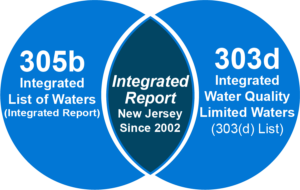
In 2002, New Jersey combined these requirements into one biennial, integrated water quality assessment report that provides the information about New Jersey’s water resources, current water quality conditions, and causes and sources of water quality impairment needed to inform and guide water quality monitoring, restoration and protection efforts conducted at the state, regional, watershed and local levels. The Integrated Water Quality Assessment Report (Integrated Report) combines and satisfies the reporting and public participation requirements of Sections 305(b) and 303(d) of the federal Clean Water Act (along with Section 314 Clean Lakes Program).
The information provided in the Integrated Reports is also used to establish funding and implementation priorities for enhancing and protecting waters of the State and the uses and benefits (public health, environmental, and economic) they provide.
Assessment Cycle

|
|
New Jersey Water Regions
